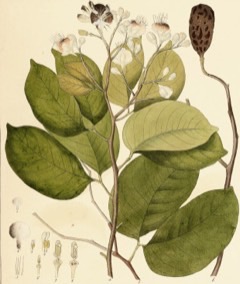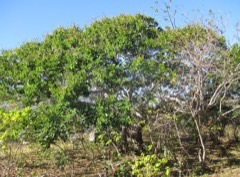 |
|
edibleplants.org |
 |
| mobot.org Henry T. Wright |
Translate this page:
Summary
Physical Characteristics

 Hymenaea verrucosa is an evergreen Tree growing to 15 m (49ft) by 15 m (49ft) at a slow rate.
Hymenaea verrucosa is an evergreen Tree growing to 15 m (49ft) by 15 m (49ft) at a slow rate.
See above for USDA hardiness. It is hardy to UK zone 10. The flowers are pollinated by Bees.
Suitable for: medium (loamy) and heavy (clay) soils and prefers well-drained soil. Suitable pH: mildly acid and neutral soils and can grow in saline soils.
It cannot grow in the shade. It prefers dry or moist soil and can tolerate drought.
UK Hardiness Map
US Hardiness Map
Synonyms
Trachylobium hornemannianum Hayne Trachylobium verrucosum (Gaertn.) Oliv.
Plant Habitats
Edible Uses
References More on Edible Uses
Medicinal Uses
Plants For A Future can not take any responsibility for any adverse effects from the use of plants. Always seek advice from a professional before using a plant medicinally.
None known
References More on Medicinal Uses
The Bookshop: Edible Plant Books
Our Latest books on Perennial Plants For Food Forests and Permaculture Gardens in paperback or digital formats.

Edible Tropical Plants
Food Forest Plants for Hotter Conditions: 250+ Plants For Tropical Food Forests & Permaculture Gardens.
More

Edible Temperate Plants
Plants for Your Food Forest: 500 Plants for Temperate Food Forests & Permaculture Gardens.
More

More Books
PFAF have eight books available in paperback and digital formats. Browse the shop for more information.
Shop Now
Other Uses
The roots, trunk and fruits yield copal[46 , 364 ]. Much copal can be obtained from semi-fossilized material dug from the soil[46 ]. Copal is a hard resin that is obtained from various tropical trees and is used to make varnish. The wood is heavy and hard. It is used for general construction, flooring, joinery, bridges, sleepers, firewood, charcoal, poles and tool handles[364 ].
Special Uses
Carbon Farming
References More on Other Uses
Cultivation details
Industrial Crop: Hydrocarbon Management: Standard Regional Crop
The flowers are very attractive to bees[307 ]. This plant is the closest living species to the extinct species H. mexicana, which was found in amber from the mines of Chiapas, Mexico[328 ]. This fact indicates a former physical connection between the land mass of Africa and that of S. America[328 ]. This species has a symbiotic relationship with certain soil bacteria; these bacteria form nodules on the roots and fix atmospheric nitrogen. Some of this nitrogen is utilized by the growing plant but some can also be used by other plants growing nearby[755 ].
Carbon Farming
-
Industrial Crop: Hydrocarbon
Materials, chemicals and energy include bioplastics, rubber, biomass products gasoline, jet fuel, diesel, butane, propane, biogas. Plants are usually resprouting plants and saps.
-
Management: Standard
Plants grow to their standard height. Harvest fruit, seeds, or other products. Non-Destructive management systems.
-
Regional Crop
These crops have been domesticated and cultivated regionally but have not been adopted elsewhere and are typically not traded globally, Examples in this broad category include perennial cottons and many nuts and staple fruits.
References Carbon Farming Information and Carbon Sequestration Information
Temperature Converter
Type a value in the Celsius field to convert the value to Fahrenheit:
Fahrenheit:
The PFAF Bookshop
Plants For A Future have a number of books available in paperback and digital form. Book titles include Edible Plants, Edible Perennials, Edible Trees,Edible Shrubs, Woodland Gardening, and Temperate Food Forest Plants. Our new book is Food Forest Plants For Hotter Conditions (Tropical and Sub-Tropical).
Shop Now
Plant Propagation
Seed - freshly sown, still moist seed does not require pre-treatment, but if the seedcoat has dried and hardened then it will require some treatment to help it absorb moisture more rapidly. This can be done by soaking the seed for 12 hours in warm water - if it swells it can be sown, otherwise carefully nick the seedcoat, making sure not to damage the embryo, then soak for a few hours more before sowing[K ]. Sow the seed in light shade in individual containers or a nursery seedbed. Treated seed usually starts to sprout after 8 - 12 days at an optimal temperature of 30°c[325 ]. Softwood cuttings in misted beds with steam or electrically heated soil[303 ].
Other Names
If available other names are mentioned here
Madagascar copal, Muacarecuite, Pohon kopal afrika timur, Pohon zanzibar, Umcumbi
Native Range
AFRICA: Kenya, Tanzania, Mozambique, Madagascar, Mauritius, Seychelles
Weed Potential
Right plant wrong place. We are currently updating this section.
Please note that a plant may be invasive in one area but may not in your area so it's worth checking.
None Known
Conservation Status
IUCN Red List of Threatened Plants Status : This taxon has not yet been assessed

Growth: S = slow M = medium F = fast. Soil: L = light (sandy) M = medium H = heavy (clay). pH: A = acid N = neutral B = basic (alkaline). Shade: F = full shade S = semi-shade N = no shade. Moisture: D = dry M = Moist We = wet Wa = water.
Now available:
Food Forest Plants for Mediterranean Conditions
350+ Perennial Plants For Mediterranean and Drier Food Forests and Permaculture Gardens.
[Paperback and eBook]
This is the third in Plants For A Future's series of plant guides for food forests tailored to
specific climate zones. Following volumes on temperate and tropical ecosystems, this book focuses
on species suited to Mediterranean conditions—regions with hot, dry summers and cool, wet winters,
often facing the added challenge of climate change.
Read More
Expert comment
Author
Gaertn.
Botanical References
Links / References
For a list of references used on this page please go here
A special thanks to Ken Fern for some of the information used on this page.
Readers comment
| Add a comment |
|
If you have important information about this plant that may help other users please add a comment or link below. Only comments or links that are felt to be directly relevant to a plant will be included. If you think a comment/link or information contained on this page is inaccurate or misleading we would welcome your feedback at [email protected]. If you have questions about a plant please use the Forum on this website as we do not have the resources to answer questions ourselves.
* Please note: the comments by website users are not necessarily those held by PFAF and may give misleading or inaccurate information.
To leave a comment please Register or login here All comments need to be approved so will not appear immediately.
|
Subject : Hymenaea verrucosa
|
|
|
|